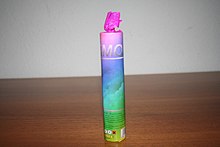Smoke grenade
A smoke grenade , even mist grenade , fog candle , smoke pots , fog bomb or smoke pot called, is a grenade , a strong smoke - or fog development generated and as a smoke or signal means is used. As a rule, an explosion does not take place, but the charge burns slowly ( pyrotechnically ) with a strong development of smoke .
Areas of application
military
Smoke grenades are used militarily - by artillery , mortars , smoke- throwing devices on vehicles and from aircraft - primarily against ground troops, in order to make it difficult for the enemy to see one's own forces, to make orientation more difficult and to camouflage one's own forces. Often an own attack is prepared with the use of smoke grenades in order to make it more difficult for the opponent to defend against the subsequent own attack. Fog acid barrel devices are used for camouflage .
In the area of the self-protection of military vehicles, particular importance is attached to the fact that the fog is effective not only in the visible frequency spectrum, but also in the infrared range.
Colored smoke grenades can be used as target marks for an air rescue or air raid . For this purpose, smoke sets are used that produce intensely colored smoke.
In the Bundeswehr, the use of smoke bombs is regulated in the Central Service Regulation (ZDv) 3/21 “Use of smoke agents”. The following smoke agents are in use
- The smoke missile body DM ( German model designation ) 15 can be ignited with electrical ignition from a smoke throwing system (for example an armored vehicle) or manually with a friction igniter. It develops fog over 3.5 minutes and contains 880 g fog substance HC . This is a mixture of hexachloroethane , aluminum powder and zinc oxide . The smoke contains zinc chloride , which forms fog with the humidity.
- The DM35 rapid smoke cannon can only be fired from a smoke launch system. The missile is ignited electrically, disintegrates in 3 seconds and develops fog for 1.5 minutes. The throwing body contains 630 g of red phosphorus based smoke substance RP . The phosphorus burns to phosphorus pentoxide , which hydrolyzes to phosphoric acid in the air .

Sporting events
Smoke bombs are occasionally burned at sporting events (mostly soccer ) in stadiums or at concerts by fans , often in connection with Bengal fires . Different smoke colors are usually used, such as the club colors of their own team. Since the burning of fireworks in German stadiums is normally forbidden by stadium regulations, in contrast to military smoke grenades, massive metal or plastic containers are usually not used as a casing for the smoke powder , but the powder is carried loosely in small bags and then burned on the floor. The powder used for civil purposes differs greatly from the military powder in terms of its composition.
Distress signal
Floatable smoke bodies are used as distress signaling devices : In strong winds, the smoke plume visible from the air for kilometers can show aircraft the way.
construction

When various chemicals are added, such as potassium nitrate (saltpeter), the grenades usually produce white to gray camouflage smoke . With the appropriate additives, colored signal smoke results . A frequently used substance is white phosphorus , which burns in the air to form phosphoric acid mist. Further chemicals are titanium tetrachloride , tin tetrachloride or chlorosulphonic acid , which after spraying also hydrolyze to acid mist . The resulting mist can be harmful to health and should not be inhaled if possible.
See also
literature
- United States. Army. Corps of Engineers, Gas Warfare Bulletin , 1918, Volume 1, S.124ff Smoke Generators , (eng.)
